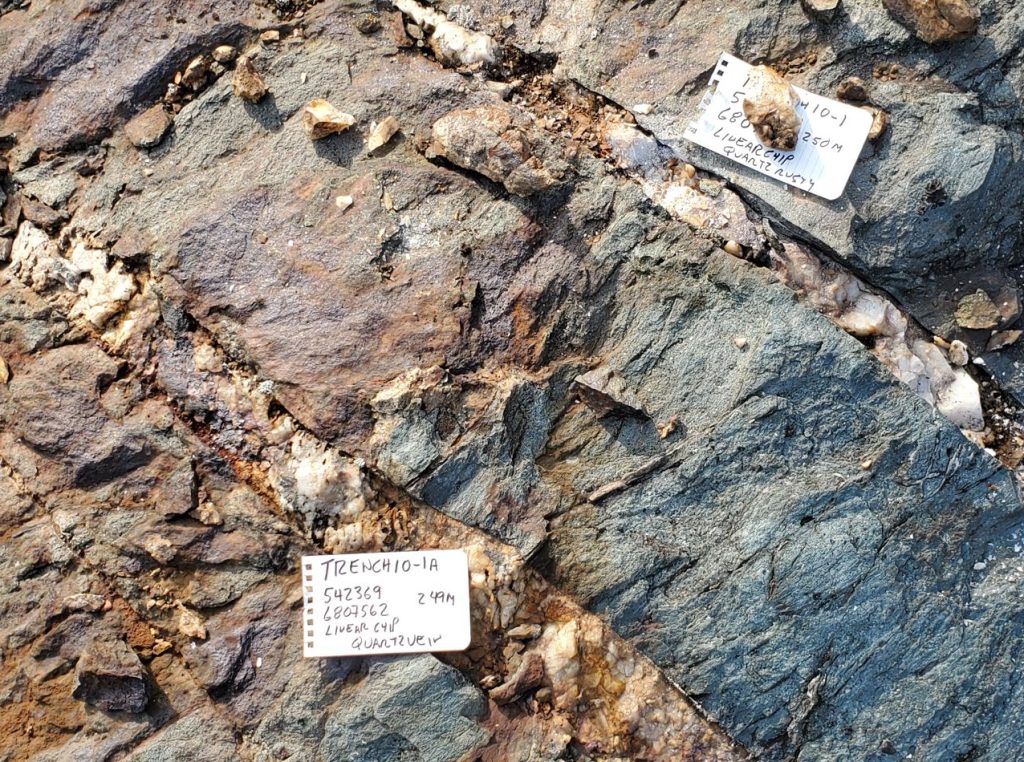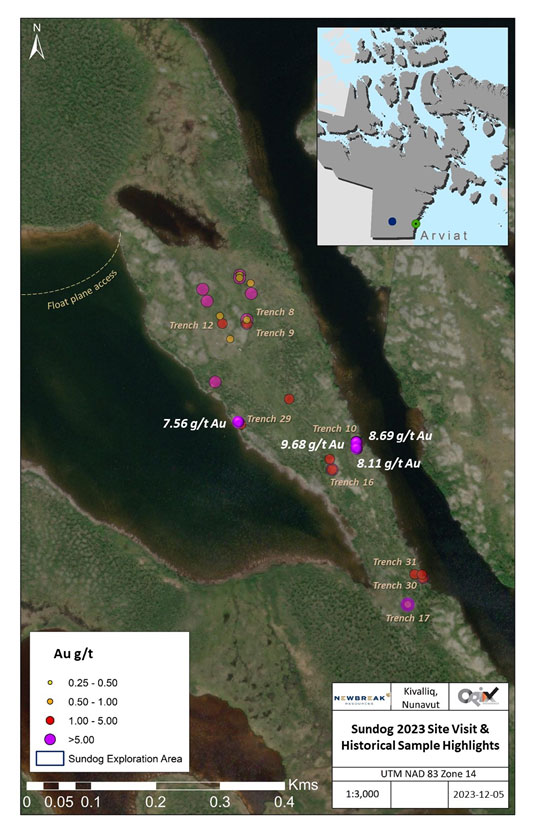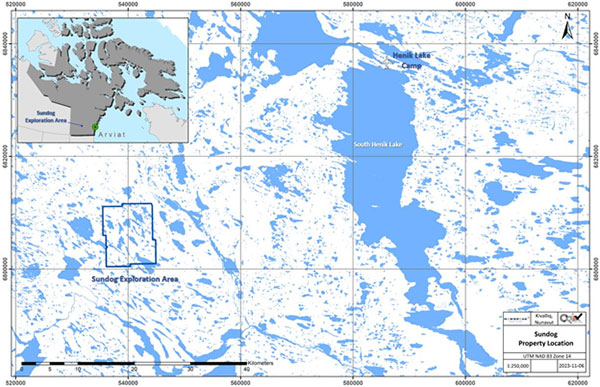New Break Identifies New Gold Bearing Structures at the Sundog Project in Nunavut

New Break Resources Ltd. (“New Break” or the “Company”) (CSE: NBRK) is pleased to report that the results from rock chip and grab samples taken from the Sundog Gold Project in Kivalliq Region, Nunavut (“Sundog”) have identified new gold bearing structures on the property, with half of the eight samples taken grading over 7.5 grams per tonne gold (“g/t Au”) as shown in the following table:
Table 1: 2023 Sundog Sample Highlights
| Sample ID | Type | Description and Location | Grade (g/t Au)(1) |
| 211954 | Rock chip | New quartz vein near 1987 Trench 29 | 7.56 |
| 211957(2) | Grab | Quartz vein sulfide within 1987 Trench 10 | 8.11 |
| 211958 | Rock chip | New quartz vein near 1987 Trench 10 | 9.68 |
| 211959 | Rock chip | New quartz vein near 1987 Trench 10 | 8.69 |
- Grade determined through fire assay.
- A reference sample taken from the same location as sample 211957 exhibits visible gold on the cut surface.
The samples were taken in September 2023, by a New Break field team comprised of Ken Reading, Shaun Parent, P. Geo. of Superior Exploration Ltd. and a field assistant, who confirmed access to the project area and assessed the impact of environmental changes since Reading’s last visit to the property in 2013. New Break was able to reproduce a high-grade gold assay from trench 10 and most importantly, the team was able to identify previously unknown gold bearing structures adjacent to trenches 10 and 29, extending the known extent of those mineralized zones.
Ken Reading originally visited Sundog on behalf of Abermin Corporation (“Abermin”) in the summers of 1986 and 1987. During the 1987 exploration program, 38 trenches were excavated and mapped by Reading with 27 of those sampled. The trench references in this news release refer to those 1987 locations, which are shown in Figure 1 below.
Some of the best assay results have come from the Trench 10 location, which was excavated at the site of the original 1962 showing discovered by Selco Exploration, and from areas represented by Trenches 17 and 29.
In his June 1986 trip to Sundog, Reading took 9 grab samples, 6 from the Trench 10 area and 3 from the Trench 29 area, with the best assay being 62.8 g/t Au. In August 1986, Reading collected a further 26 rock chip and 13 panned concentrate (“PC”) samples from Trenches 17 and 29 areas, with most taken from Trench 17 area. PC samples included 206.7 g/t Au from the Trench 17 area and 127.6 g/t Au from the Trench 29 area. The rock chip sample highlights are shown in Table 2.
Table 2: August 1986 Sundog Sample Highlights
| Sample ID | Type | Location | Grade (g/t Au) |
| SD-86-007 | Rock chip | 25 feet south of Trench 17 | 4.05 |
| SD-86-014 | Rock chip | Trench 17 | 9.87 |
| SD-86-017 | Rock chip | Trench 17 | 39.09 |
Visit https://www.newbreakresources.ca/projects/nunavut-gold-projects/sundog-gold-project/ for full details of the August to September 1986 sampling program.

(Figure 1: Select 1987 Trench Locations, 2023 and historical sample assays – Sundog Gold Project)
As noted previously, in August and September 1987, 38 trenches were excavated and mapped by Reading with 27 of those sampled. Sample highlights from the 1987 program are shown in Table 3.
Table 3: August – September 1987 Sundog Sample Highlights
| Sample ID | Type | Location | Grade (g/t Au) |
| KR-SD-87-208 | Grab | Trench 8 | 6.40 |
| KR-SD-87-292 | Grab | Trench 9 | 8.72 |
| KR-SD-87-301 | Grab | Trench 9 | 6.72 |
| KR-SD-87-293 | Grab | Trench 9 | 4.24 |
| KR-SD-87-210 | Grab | Trench 9 | 3.24 |
| KR-SD-87-273 | Grab | Trench 10 | 97.60 |
| KR-SD-87-304 | Grab | Trench 10 | 56.40 |
| KR-SD-87-315 | Grab | Trench 10 | 8.26 |
| KR-SD-87-313 | Grab | Trench 10 | 7.34 |
| KR-SD-87-271 | Grab | Trench 10 | 7.12 |
| KR-SD-87-309 | Grab | Trench 10 | 2.76 |
| KR-SD-87-231 | Grab | Trench 12 | 4.64 |
| KR-SD-87-237 | Grab | Trench 16 | 1.76 |
| KR-SD-87-254 | Grab | Trench 17 | 11.60 |
| KR-SD-87-270 | Grab | Trench 17 | 3.64 |
| KR-SD-87-263 | Grab | Trench 17 | 1.54 |
| KR-SD-87-249 | Grab | Trench 30 | 3.28 |
| KR-SD-87-251 | Grab | Trench 30 | 1.82 |
| KR-SD-87-248 | Grab | Trench 31 | 2.12 |
David Reid, Senior Geologist at Abermin, prepared a report dated January 1988, which covered the exploration work completed in 1986 and 1987. Reid reported the occurrence of coarse visible gold in a series of quartz-rubble pits. When the presence of coarse gold is suspected, pulp metallics can be used as a more representative assay technique. Abermin decided to complete pulp metallics assays on all 1987 samples. Reid reported that the in a number of cases, “a significant amount of coarse gold exists both in samples containing gold prior to the metallics analysis and also in samples considered to be background in concentration. In several cases, the total concentration of gold in the sample was more than doubled.”
Next Exploration Steps
New Break plans to undertake a summer 2024 field season at Sundog, subject to regulatory and Inuit approvals and financing, in order to complete the following objectives:
- Systematically sample potentially gold bearing structures and in-situ veins;
- Complete drone magnetics and very low frequency (“VLF”) geophysical surveys;
- Complete reconnaissance mapping and sampling along strike length and parallel structures within the Sundog concession;
- Further define gold bearing systems between fine and coarse gold environments; and
- Complete a preliminary drilling program on the Sundog property, the first of its kind.
Bill Love, New Break’s Vice-President, Exploration commented, “The results of New Break’s September trip to Sundog exceeded our expectations. The assays from the limited sampling program confirmed the existence of high-grade gold at surface, including visible gold in the trench 10 sample and new gold bearing structures which were located with very little effort. Ken Reading has also been able to confirm that there has been no historical glacial movement at Sundog, meaning the gold found in the overlying surface rubble reflects in-situ gold and not a glacial dispersion train, which significantly increases our ability to target planned drilling. The evidence of coarse gold also has the potential to yield a higher average resource grade in the event that a mineral resource is ultimately estimated in the future. Combined with the historical assay results at Sundog, these results confirm that in addition to New Break’s Moray property in Ontario, the Company has another significant Canadian gold exploration property of merit.”
About the Sundog Gold Project
Sundog is located approximately 235 km west of Arviat, Nunavut, 640 km north of Thompson, Manitoba and lies 16 km to the northeast of the Cullaton Lake airstrip on parcel AR-35 of Inuit Owned Land and covers approximately 9,415 hectares (the “Exploration Area”) as shown in Figure 2. The surface rights are managed by the Kivalliq Inuit Association (“KIVIA”) and administration of mineral rights is managed by Nunavut Tunngavik Incorporated (“NTI”). The Exploration Area represents an under-explored part of the Henik Group, central Ennadai-Rankin Archean greenstone belt, the second largest greenstone belt in Canada, second only to the Abitibi greenstone belt in Ontario and Quebec. The Sundog property is characterized by high grade surface gold exposures. There are two banded iron formations on the property, with the potential for Musselwhite-Meadowbank-Meliadine type mineralization.

(Figure 2: Sundog Gold Project – Property Location)
2023 Quality Assurance and Quality Control (QA/QC)
New Break collected 8 samples during the September 2023 sampling trip. Shaun Parent, P. Geo. supervised the collection of the samples. The samples were delivered to Activation Laboratories Ltd. (“Actlabs”) in Ancaster, Ontario. The samples were crushed to up to 80% passing 2mm, riffle split (250g) and pulverized to 95% passing 105 micrometres. Seven of the samples were subject to fire assay with atomic absorption (“AA”) finish. Samples assaying greater than 5.0 g/t Au were rerun by fire assay with a gravimetric finish. One sample (Trench 10 sample) was also run for multi element data in addition to being rerun by fire assay with a gravimetric finish.
For multi element analysis, a 0.25g sample was digested with four acids beginning with hydrofluoric, followed by a mixture of nitric and perchloric acids, heated using precise programmer-controlled heating in several ramping and holding cycles which takes the samples to dryness. After dryness is attained, samples are brought back into solution using hydrochloric and nitric acids. This digestion may not be completely total as resistate minerals are present. Digested samples are diluted and analyzed by an ICP-MS. Actlabs is accredited by the Standards Council of Canada under the requirements of ISO/IEC 17025:2017.
Qualified Person
Peter C. Hubacheck, P. Geo., consulting geologist to New Break, and a Qualified Person as defined by National Instrument 43-101, has reviewed and approved the technical disclosure in this news release.
About New Break Resources Ltd.
New Break is a Canadian mineral exploration company with a dual vision for value creation. In northern Ontario, New Break is focused on its Moray Project, in a well-established mining camp, within proximity to existing infrastructure, while at the same time, through our prospective land holdings in Nunavut that include the Sundog, Esker-Noomut, Sy and Angikuni Lake properties, we provide our shareholders with significant exposure to the vast potential for exploration success in one of the most up and coming regions in Canada for gold exploration and production. New Break is supported by a highly experienced team of mining professionals committed to placing a premium on Environmental, Social and Corporate Governance. Information on New Break is available under the Company’s profile on SEDAR+ at www.sedarplus.ca and on the Company’s website at www.newbreakresources.ca. New Break began trading on the Canadian Securities Exchange (www.thecse.com) on September 7, 2022 under the symbol CSE: NBRK.
For further information on New Break, please visit www.newbreakresources.ca or contact:
Michael Farrant, President and Chief Executive Officer
Tel: 416–278–4149
E-mail: mfarrant@newbreakresources.ca
And follow us on Twitter, LinkedIn and Facebook
No stock exchange, regulation securities provider, securities commission or other regulatory authority has approved or disapproved the information contained in this news release.
CAUTIONARY NOTE REGARDING FORWARD LOOKING INFORMATION
Except for statements of historic fact, this news release contains certain “forward-looking information” within the meaning of applicable securities law. Forward-looking information is frequently characterized by words such as “plan”, “expect”, “project”, “intend”, “believe”, “anticipate”, “estimate” and other similar words, or statements that certain events or conditions “may” or “will” occur. Forward-looking statements are based on the opinions and estimates at the date the statements are made, and are subject to a variety of risks and uncertainties and other factors that could cause actual events or results to differ materially from those anticipated in the forward-looking statements including, but not limited to receipt of regulatory and stock exchange approvals, grants of equity-based compensation, renouncement of flow-through exploration expenses, property agreements, timing and content of upcoming work programs, geological interpretations, receipt of property titles, an inability to predict and counteract the effects global events on the business of the Company, including but not limited to the effects on the price of commodities, capital market conditions, restriction on labour and international travel and supply chains etc. Forward-looking information addresses future events and conditions and therefore involves inherent risks and uncertainties, including factors beyond the Company’s control. Accordingly, readers should not place undue reliance on forward-looking information. The Company undertakes no obligation to update publicly or otherwise any forward-looking information, except as may be required by law. Additional information identifying risks and uncertainties that could affect financial results is contained in the Company’s financial statements and management’s discussion and analysis (the “Filings”), such Filings available upon request.
